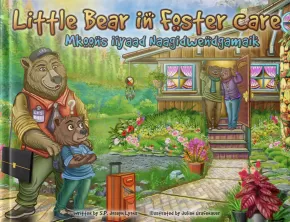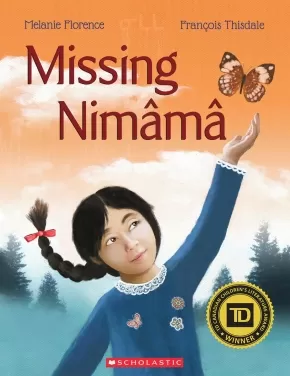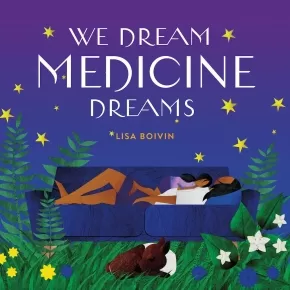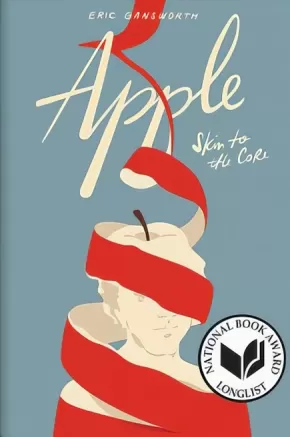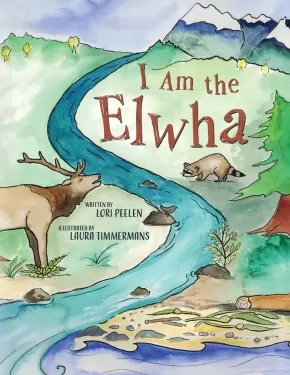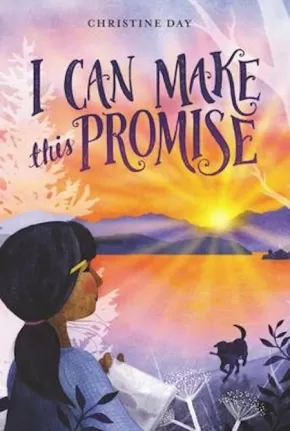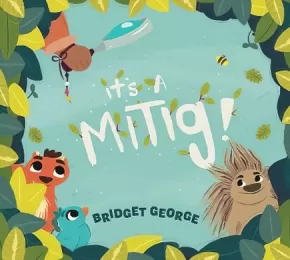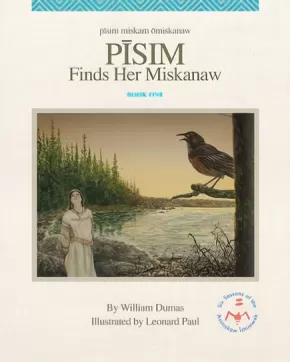
Award-Winning
46
-
60
of
104 Results;
Sort By
Go To
of 7
Little Bear in Foster Care / Mkoons iiyaad Naagidwendgamaik
$19.95
Artists:
Format:
Paperback
Text Content Territories:
Indigenous Canadian; First Nations; Anishinaabeg;
ISBN / Barcode: 9781990297045
Synopsis:
Synopsis:
Algonquin author S.P. Joseph Lyons, from Kitigan Zibi First Nation, was placed in foster care as a young child and is a survivor of the Sixties Scoop. Foster Care can be scary and lonely. Through S.P. Joseph Lyons’ experiences, the Little Bear in Foster Care book makes foster care a little less frightening.
Little Bear in Foster Care connects children to a range of emotions, encourages them to find their voice, and lets them know they are not alone or to blame. Through Little Bear in Foster Care, S.P. Joseph Lyons helps young children process their feelings and experiences.
The richness of Indigenous cultures and emotions come alive in this story of healing and resilience. This is an important book for adults to read to all young children. Little Bear in Foster Care is geared for young school-aged children.
Little Bear gives voice to the feelings and fears children experience when placed in confusing and unfamiliar environments.
Awards
- 2022 Co-winner of the First Nation Communities READ PMC Indigenous Literature Award, Children’s Category winner
Educator & Series Information
Includes information about smudging, talking feathers, and traditional circles.
This book is part of the Foster Care Series.
Little Bear in Foster Care is a dual language book written in Anishinaabemowin, the language of the Anishinaabeg, and English. Translated by Potawatomi Odawa Elder and Language Keeper, Mawla Shawana, from Wikwemikong Unceded Territory. With vibrant illustrations by Julian Grafenauer, Ojibwe, from Rolling River First Nation.
Additional Information
32 Pages | Paperback
Mii maanda ezhi-gkendmaanh / This Is How I Know
$19.99
Format:
Hardcover
Text Content Territories:
Indigenous Canadian; First Nations; Anishinaabeg;
ISBN / Barcode: 9781773063263
Synopsis:
Synopsis:
Niibing, dgwaagig, bboong, mnookmig dbaadjigaade maanpii mzin'igning / A Book about the Seasons.
An Anishinaabe child and her grandmother explore the natural wonders of each season in this lyrical, bilingual story-poem.
In this lyrical story-poem, written in Anishinaabemowin and English, a child and grandmother explore their surroundings, taking pleasure in the familiar sights that each new season brings.
We accompany them through warm summer days full of wildflowers, bees and blueberries, then fall, when bears feast before hibernation and forest mushrooms are ripe for harvest. Winter mornings begin in darkness as deer, mice and other animals search for food, while spring brings green shoots poking through melting snow and the chirping of peepers.
Brittany Luby and Joshua Mangeshig Pawis-Steckley have created a book inspired by childhood memories of time spent with Knowledge Keepers, observing and living in relationship with the natural world in the place they call home — the northern reaches of Anishinaabewaking, around the Great Lakes.
Alvin Ted Corbiere and Alan Corbiere, father and son, are the Anishinaabe translators of this work.
Awards
- 2022 Indigenous Voices Award for a published work in an Indigenous language
Educator Information
Recommended for ages 3 to 7.
Correlates to the Common Core State Standards in English Language Arts:
CCSS.ELA-LITERACY.RL.2.1
Ask and answer such questions as who, what, where, when, why, and how to demonstrate understanding of key details in a text.
CCSS.ELA-LITERACY.RL.2.2
Recount stories, including fables and folktales from diverse cultures, and determine their central message, lesson, or moral.
CCSS.ELA-LITERACY.RL.K.6
With prompting and support, name the author and illustrator of a story and define the role of each in telling the story.
CCSS.ELA-LITERACY.RL.1.4
Identify words and phrases in stories or poems that suggest feelings or appeal to the senses.
CCSS.ELA-LITERACY.RL.2.5
Describe the overall structure of a story, including describing how the beginning introduces the story and the ending concludes the action.
How do you know the seasons? Do you know it's summer when blueberries fall readily and the sand is hot enough to sting? Do you know fall by the red-winged blackbird taking his leave? Take a minute and look around — nature is speaking to us. Changes are happening, and Mother Earth is letting us know at every step of the way. Whether it's the sun's bright morning light, or the white moon sitting high in the sky, there are many ways to know what time of the year it is. All we need to do is stop, look, and listen, because each season tells us a story!
This book is also available in French and Ojibwe: Mii maanda ezhi-gkendmaanh / La Terre me parle: Un livre sur les saisons
Additional Information
44 pages | 8.75" x 8.50"
Missing Nimâmâ
$8.99
Artists:
Format:
Hardcover
Text Content Territories:
Indigenous Canadian; First Nations; Cree (Nehiyawak);
ISBN / Barcode: 9781039708181
Synopsis:
Synopsis:
A beautiful, transcendent story of a mother-daughter connection that persists through tragedy and across time.
Kateri is a young Cree girl, growing up in the care of her grandmother. We see her reaching important milestones: her first day of school, first dance, first date, wedding, first child. Her mother is absent, but not gone, watching her child growing up without her.
Told in alternating voices of child and mother, Missing Nimâmâ is a story of love, loss, and acceptance, showing the human side of a national tragedy. Dreamlike illustrations by François Thisdale enrich Kateri’s emotional journey. An afterword by the author provides a simple, age-appropriate context for young readers. Includes Cree words and glossary.
Reviews
"A free-verse intergenerational story of separation, loss, and daughter-mother connection amid the ongoing crisis of missing First Nations girls and women. . . On each page, Cree author Florence presents two narratives: Kateri's and her missing nimâmâ's. By juxtaposing the daughter's and mother's thoughts and feelings in complementary verse, Florence provides them the opportunity to experience life together from their respective points of view and to talk to each other from a distance. Thisdale's soft-edged, wistful artwork enriches the heartfelt story, strongly capturing the passage of time and Kateri's emotional journey. An afterword is appended, offering simple and relevant information as well as statistics of missing and murdered indigenous girls and women; together with the story, it should help to begin a conversation with young readers. A solid debut picture book that works as a record of voices that are usually unheard, ignored, and forgotten." — Kirkus Reviews
"A touching story related from the point of view of a missing indigenous woman as she watches her daughter grow up without her."— Quill and Quire
Awards
- TD Canadian Children's Literature Award Winner
Educator Information
This is a picture book best suited for more mature readers, as it deals with mature themes and subject matter. It's best used for a read-aloud due to its subject matter and theme of loss. This book is not recommended as an independent read for younger ages.
Additional Information
32 pages | 8.50" x 11.00"
On the Trapline
$24.99
Artists:
Format:
Hardcover
Text Content Territories:
Indigenous Canadian; First Nations; Cree (Nehiyawak); Swampy Cree ;
ISBN / Barcode: 9780735266681
Synopsis:
Synopsis:
A picture book celebrating Indigenous culture and traditions. The Governor General Award-winning team behind When We Were Alone shares a story that honors our connections to our past and our grandfathers and fathers.
A boy and Moshom, his grandpa, take a trip together to visit a place of great meaning to Moshom. A trapline is where people hunt and live off the land, and it was where Moshom grew up. As they embark on their northern journey, the child repeatedly asks his grandfather, "Is this your trapline?" Along the way, the boy finds himself imagining what life was like two generations ago -- a life that appears to be both different from and similar to his life now. This is a heartfelt story about memory, imagination and intergenerational connection that perfectly captures the experience of a young child's wonder as he is introduced to places and stories that hold meaning for his family.
Awards
- 2021 Governor General's Literary Award for young people's literature -- illustrated books
- 2022 Shining Willow Award
- 2022 TD Canadian Children's Literature Award winner
- 2023 Chocolate Lily Award
Educator Information
Recommended for ages 4 to 8.
Shares and teaches some Swampy Cree words throughout the story.
Notes from the author and illustrator, as well as a glossary of the Swampy Cree words used in the story and a pronunciation guide are included.
This book is available in French: Ligne de trappe.
Additional Information
48 pages | 8.00" x 9.00"
The Power of Style: How Fashion and Beauty Are Being Used to Reclaim Cultures
$14.95
Format:
Paperback
Text Content Territories:
Indigenous Canadian;
ISBN / Barcode: 9781773214917
Synopsis:
Synopsis:
Style is not just the clothes on our backs—it is self-expression, representation, and transformation.
As a fashion-obsessed Ojibwe teen, Christian Allaire rarely saw anyone that looked like him in the magazines or movies he sought out for inspiration. Now the Fashion and Style Writer for Vogue, he is working to change that—because clothes are never just clothes. Men’s heels are a statement of pride in the face of LGTBQ+ discrimination, while ribbon shirts honor Indigenous ancestors and keep culture alive. Allaire takes the reader through boldly designed chapters to discuss additional topics like cosplay, makeup, hijabs, and hair, probing the connections between fashion and history, culture, politics, and social justice.
Reviews
“A vibrant read about the connections between fashion, culture, and social justice.” — Kirkus Reviews, 02/23/21
“The book to appeal to a wide age range. It is important that readers of all ages be given the opportunity to learn that there are others who have had the same or similar experiences of feeling that they were different from their peers because of the way that they looked or dressed. Highly Recommended.” — CM Reviews, 02/12/21
“Dazzling and empowering . . . Fab drag queens, genderqueer and BIPOC YouTubers demoing makeup, plus-size and gender-bending cosplayers, men wearing high heels and fem fashion—they’re all here, a proud and dazzling explosion of confetti transforming the landscape.” — Booklist, *starred review, 03/02/21
Educator Information
Recommended for ages 12+
Common Core Correlations
CCSS.ELA-Literacy Strand-Reading literature:
W.6.1,1a,1b,1c,1d,1e
SL.6.1,1a,1b,1c,1d,1
RI.6.1,2,3,4,5,6,7,8
L.6.1,1a,2,2a,2b,3,3
Reading Level: Lexile 1070L
The Power of Style is a Top Ten Quick Picks for Reluctant Young Adult Readers, YALSA
Additional Information
96 pages | 8.00" x 10.00"
Treaty Words: For As Long As the Rivers Flow
$16.95
Format:
Hardcover
Text Content Territories:
Indigenous Canadian; First Nations; Anishinaabeg;
ISBN / Barcode: 9781773214962
Synopsis:
Synopsis:
The first treaty that was made was between the earth and the sky. It was an agreement to work together. We build all of our treaties on that original treaty.
On the banks of the river that have been Mishomis’s home his whole life, he teaches his granddaughter to listen—to hear both the sounds and the silences, and so to learn her place in Creation. Most importantly, he teaches her about treaties—the bonds of reciprocity and renewal that endure for as long as the sun shines, the grass grows, and the rivers flow.
Accompanied by beautiful illustrations by Luke Swinson and an author’s note at the end, Aimée Craft affirms the importance of understanding an Indigenous perspective on treaties in this evocative book that is essential for readers of all ages.
Awards
- 2022 Indigenous Voices Award in the graphic novels, comics, and illustrated books category
Educator Information
Recommended for ages 10+
Target Grade: Grade 5
Reading Level: Lexile 920L
CCSS.ELA-Literacy Strand-Reading literature:
SL.3.1,1a,1b,1c,1d,2
W.3.1,1a.1b,1c,1d,1e
L.3.1,1a,1b,1c,1d.1e
RL.3.1,2,3,4,5,6,7,9
This book is available in French: Mishomis raconte les traités: Tant que les rivières couleront
Additional Information
60 pages | 4.00" x 6.00"
We All Play (HC)
$22.95
Artists:
Format:
Hardcover
Text Content Territories:
Indigenous Canadian; First Nations; Cree (Nehiyawak);
ISBN / Barcode: 9781771646079
Synopsis:
Synopsis:
From Julie Flett, the beloved author and illustrator of Birdsong, comes a joyous new book about playtime for babies, toddlers, and kids up to age 7.
Animals and kids love to play! This wonderful book celebrates diversity and the interconnectedness of nature through an Indigenous perspective, complete with a glossary of Cree words for wild animals at the back of the book, and children repeating a Cree phrase throughout the book. Readers will encounter birds who chase and chirp, bears who wiggle and wobble, whales who swim and squirt, owls who peek and peep, and a diverse group of kids who love to do the same, shouting: We play too! / kimêtawânaw mîna
A beautiful ode to the animals and humans we share our world with, We All Play belongs on every bookshelf.
Awards
- 2021 Bull-Bransom Illustration Award Winner
- 2022 Best Book for Babies
Reviews
“Everyone loves to play! Award-winning author/illustrator Flett shares the joyful antics of young animals as they romp in much the same way as human children…This celebration of nature is sprinkled with words from the Cree language… [and] celebrate[s] our interconnection with the creatures who share our world.” —Kirkus Reviews, starred review
“Cree-Métis artist Flett starts with quiet, elegant portraits of animals….In spare compositions, [she] aptly underlines [the kinship between animals and people] by showing animals and humans embracing play in similar ways.”—Publishers Weekly, starred review
“A beautifully illustrated book that introduces a series of young animals at play, then relates their activities to those of children … affirming our oneness with nature.”—Booklist
Educator Information
Recommended for babies, toddlers and children up to age 7.
This book is available in a board book format: We All Play (BB)
Additional Information
40 pages | 8.00" x 8.00" | Hardcover
We Dream Medicine Dreams
$21.95
Artists:
Format:
Hardcover
Text Content Territories:
Indigenous Canadian; First Nations; Dene;
ISBN / Barcode: 9781553799870
Synopsis:
Synopsis:
From Dene artist and bioethicist Lisa Boivin comes this healing story of hope, dreams, and the special bond between grandfather and granddaughter.
When a little girl dreams about a bear, her grandfather explains how we connect with the knowledge of our ancestors through dreams. Bear, Hawk, Caribou, and Wolf all have teachings to share to help us live a good life. But when Grampa gets sick and falls into a coma, the little girl must lean on his teachings as she learns to say goodbye.
Masterful prose and stunning collage weave a gentle story about life and death that will touch the hearts of children and adults alike.
Awards
- 2022 Co-winner of the First Nation Communities READ PMC Indigenous Literature Award, Children’s Category winner
Reviews
"How we deal with loss, and the personal, cultural, and community ways we do that, is an urgent issue. Lisa Boivin's work is as soulful and compelling as it is beautiful!— Dr. Allison Crawford
"In We Dream Medicine Dreams, Lisa Boivin uses her powerful words and pictures to show us natural laws and teachings. These teachings about the medicine power of dreams, family, loss, and connection resonate with Indigenous and non-Indigenous people. In sharing these teachings with us, Lisa has given all those that read her book a great gift that allows the ancestors to speak with our children. This little book full of stories and teachings, which are the core of who we are, will bring us back to our ancestral selves. I encourage everyone, young and old, to spend an evening with this charming masterpiece – you will not regret it." — The Honourable Yvonne Boyer, J.D., L.L.M., L.L.D.
“I highly recommend this book. Not only did I love the incredible illustrations, which would definitely appeal to children, I also loved how this gentle story would be a great starting point when talking to children in a classroom about family loss, death and grief.” — ETFO Voice
Educator Information
Recommended for ages 5 - 8.
Author Lisa Biovin’s background as a bioethicist makes her ideally placed to discuss the subject in a way that’s sensitive and also provide both healing and hope.
The bright colours and textured feel will appeal to children.
Additional Information
48 pages | 9.00" x 9.00"
Apple (Skin to the Core)
$28.99
Format:
Hardcover
Text Content Territories:
Indigenous American; Native American; Haudenosaunee (Iroquois); Onondaga;
ISBN / Barcode: 9781646140138
Synopsis:
Synopsis:
How about a book that makes you barge into your boss's office to read a page of poetry from? That you dream of? That every movie, song, book, moment that follows continues to evoke in some way?
The term "Apple" is a slur in Native communities across the country. It's for someone supposedly "red on the outside, white on the inside."
Eric Gansworth is telling his story in Apple (Skin to the Core). The story of his family, of Onondaga among Tuscaroras, of Native folks everywhere. From the horrible legacy of the government boarding schools, to a boy watching his siblings leave and return and leave again, to a young man fighting to be an artist who balances multiple worlds.
Eric shatters that slur and reclaims it in verse and prose and imagery that truly lives up to the word heartbreaking.
Awards
- American Indian Youth Literature Award Winner
Reviews
"With language rich in metaphor, this is a timely and important work that begs for multiple readings."-Booklist, starred review
Educator Information
Recommended for ages 12 to 18.
Additional Information
352 pages | 6.50" x 9.40"
I Am the Elwha (HC)
 $18.50
$18.50

Artists:
Format:
Hardcover
Text Content Territories:
Indigenous American; Native American; Salish; Coast Salish; Klallam (Clallam); Lower Elwha Klallam Tribe;
ISBN / Barcode: 9781771744744
Synopsis:
Synopsis:
“I am the Elwha, rushing down to the sea. I am the Elwha, wild and free.”
The Elwha River flows 72 kilometres (45 miles) from its source in the Olympic Mountains to the Strait of Juan de Fuca in the Pacific Northwest. Uniquely, it hosts all six salmon species (Pink, Chinook, Coho, Sockeye, Steelhead, and Chum) as well as several species of trout.
In 1911 two dams were built on the river. The dams blocked the migration routes of the salmon and dramatically altered the entire river ecosystem for 100 years. In 2012 the dams were decommissioned and the world’s largest dam removal and habitat restoration project began.
In this lyrical and beautifully illustrated book, the author chronicles the history of the Elwha. Narrated by the powerful voices of plants and animals that inhabit the river ecosystem, the dam builder, a worker, and the river itself, this story celebrates the ongoing rewilding of this special environment and offers a welcome to all of the creatures who are coming home.
To learn more visit: www.elwha.org
Awards
- 2021 Riverby Award for Young Readers
Reviews
“I Am the Elwha is a powerful read about a powerful river and those who value and protect it." – Raina Delisle, Hakai Magazine
Educator Information
At the back of the book are three pages of cultural, scientific, and historical information that discuss the following:
- the importance and symbolism of salmon to the Lower Elwha Klallam Tribe and other Coastal Salish Tribes
- facts about the six species of salmon found in the Elwha River (Chinook, Pink, Chum, Sockeye, Coho, and Steelhead)
- the history of the Elwha River and its status today
Keywords / Subjects: The Elwha River, Rivers, Dams, History, Environmental Awareness, Lower Elwha Klallam Tribe, Coast Salish, Native American, Culture, Washington, Animals, Salmon, First Salmon Ceremony, Plants, Nature, Settlers, Social Responsibility, Environmental Activism, Poetry.
Recommended for grades 3 to 7.
Additional Information
32 Pages | 8.5" x 11" | ISBN: 9781771744744 | Hardcover
Authenticity Note: This lyrical story, which chronicles the history of the Elwha River, is written by Lori Peelen. Robert Elofson, Tribal Elder and Harvest Manager in the Natural Resources Department for the Lower Elwha Klallam Tribes, approved Lori's work and contributed a few pages of back matter at the end of the work. Lori's story was further approved by Frances Charles, the Tribal Councilwoman for the Lower Elwha Klallam Tribe, after the entire council read and approved it.
The Canadian Content label has been applied because the illustrator of this work is Canadian.
I Can Make This Promise (PB)
$12.50
Format:
Paperback
Text Content Territories:
Indigenous American; Native American; Salish; Coast Salish; Duwamish; Suquamish ;
ISBN / Barcode: 9780062872005
Synopsis:
Synopsis:
In her debut middle grade novel—inspired by her family’s history—Christine Day tells the story of a girl who uncovers her family’s secrets—and finds her own Native American identity.
All her life, Edie has known that her mom was adopted by a white couple. So, no matter how curious she might be about her Native American heritage, Edie is sure her family doesn’t have any answers.
Until the day when she and her friends discover a box hidden in the attic—a box full of letters signed “Love, Edith,” and photos of a woman who looks just like her.
Suddenly, Edie has a flurry of new questions about this woman who shares her name. Could she belong to the Native family that Edie never knew about? But if her mom and dad have kept this secret from her all her life, how can she trust them to tell her the truth now?
Reviews
“I Can Make This Promise manages to be both deeply sad and brightly hopeful, and Edie Green will steal readers’ hearts with her empathy and curious spirit—she certainly stole mine.” — Hayley Chewins, author of The Turnaway Girls
“Day’s novel brings an accessible, much-needed perspective about the very real consequences of Indigenous children being taken from their families and Native Nations. The absence of one’s tribal community, loss of culture and lack of connection to relatives have ripple effects for generations.” — Traci Sorell (Cherokee Nation), award-winning author of We Are Grateful: Otsaliheliga
"I Can Make This Promise is a story of a girl on a mission to uncover family secrets and build connections to her own Indigenous identity. When the girl learns that a white couple adopted her mother, she becomes curious about her own connections to her heritage." - The Dalai Lama Center
Educator Information
Recommended Ages: 8 to 12
Additional Information
288 pages | 5.12" x 7.62" | Paperback
Ispík kákí péyakoyak/When We Were Alone
$21.95
Artists:
Format:
Hardcover
Text Content Territories:
Indigenous Canadian; First Nations; Cree (Nehiyawak); Swampy Cree ;
ISBN / Barcode: 9781553799054
Synopsis:
Synopsis:
An empowering story of resistance that gently introduces children to the history of residential schools in Canada.
A young girl notices things about her grandmother that make her curious. Why does her grandmother have long, braided hair and beautifully coloured clothing? Why does she speak Cree and spend so much time with her family? As she asks questions, her grandmother shares her experiences in a residential school, when all of these things were taken away.
When We Were Alone won the 2017 Governor General's Literary Award in the Young People's Literature (Illustrated Books) category, and was nominated for the TD Canadian's Children's Literature Award. This edition includes the text in Swampy Cree syllabics and Roman orthography, as well as the original English.
Reviews
"When We Were Alone is a story about finding the strength to push forward when everything is against you. It follows a young girl asking her grandmother questions to learn more about her past. The grandmother shares her experience of a time when she was unable to make her own decisions and how she got through it." — The Dalai Lama Center
Educator Information
Recommended for ages 6 to 8.
This edition includes the text in Swampy Cree syllabics and Roman orthography, as well as the original English.
Translated by Alderick Leask. Alderick Leask is a respected Swampy Cree language instructor originally from Sapotaweyak Cree Nation, Manitoba. His experience includes conducting classes in Native Studies, Native Cultures, Native Languages and Canadian History from the Indigenous perspective using Traditional Elders’ Knowledge (TEK) and land-based learning. Mr. Leask places Creation and its bounties as his background in instructing students when learning basic outdoor survival skills. His usage of the functional and descriptive language of Swampy Cree demonstrates its practicality.
This book is available in an English-only format: When We Were Alone
This resource is also available in French: Quand on etait seuls
Additional Information
32 pages | 7.50" x 10.00" | Hardcover
It's a Mitig!
$24.95
Format:
Hardcover
Text Content Territories:
Indigenous Canadian; First Nations; Anishinaabeg; Ojibway;
ISBN / Barcode: 9781771622738
Synopsis:
Synopsis:
Giizis—the sun—rises. What’s hiding in the trees?
It’s a Mitig! guides young readers through the forest while introducing them to Ojibwe words for nature. From sunup to sundown, encounter an amik playing with sticks and swimming in the river, a prickly gaag hiding in the bushes and a big, bark-covered mitig.
Featuring vibrant and playful artwork, an illustrated Ojibwe-to-English glossary and a simple introduction to the double-vowel pronunciation system, plus accompanying online recordings, It’s a Mitig! is one of the first books of its kind. It was created for young children and their families with the heartfelt desire to spark a lifelong interest in learning language.
Awards
- 2021 First Nation Communities Read 2021 Winner
Reviews
"This is more than a treasure, It's a Migig is a song and a dance for the world in how fun it is to learn Anishinaabe from mentor and visionary Bridget George. I am completely charmed hoping this is the first in a series we can all enjoy together. Written with such love and tenderness, this is a gift for the world. Bravo and mahsi cho, Bridget George." — Richard Van Camp, author of Welcome Song for Baby and Little You
Educator Information
Recommended for ages 3 to 5.
Additional Information
32 pages | 10.70" x 9.55"
Pisim Finds Her Miskanaw: Revised
$29.00
Artists:
Format:
Hardcover
Text Content Territories:
Indigenous Canadian; First Nations; Cree (Nehiyawak); Woodland Cree; Rocky Cree;
ISBN / Barcode: 9781553799092
Synopsis:
Synopsis:
NOW REVISED! This edition features updated Rocky Cree translations and an expanded glossary, augmented with new maps to give a more detailed look at Pīsim’s journey. These enhancements make this book a great tool for teachers and a great addition to any library.
Out of an important archaeological discovery came this unique story about a week in the life of Pīsim, a young Cree woman, who lived in the mid 1600s. In the story, created by renowned storyteller William Dumas, Pīsim begins to recognize her miskanaw – the path for her life – and to develop her gifts for fulfilling that path. The story is brought to life by the rich imagery of Mi’kmaw artist Leonard Paul, and is accompanied by sidebars on Cree language and culture, archaeology and history, maps, songs, and more.
Reviews
"In imagining the life of a young Cree woman, this volume provides a wonderful evocation of the wisdom and language of Cree elders that seamlessly incorporates archaeology, ethnology, and oral traditions." — Stephen Loring, Arctic Studies Center, Smithsonian Institute, Washington DC
"This rich story ... brings alive the history and language of Asiniskow Ithiniwak in Manitowapow while illustrating the cultural breadth of a dynamic community. This book is a joy to read, teach, and share with my daughter." — Niigaanwewidam James Sinclair, Assistant Professor, Dept. of Native Studies University of Manitoba
"The brilliant teamwork between archaeologists, the Cree, and an accomplished storyteller gives us... a beautifully written and illustrated journey into a centuries-old world... the books promises to be a classic of Canadian history." — Brian Fagan, Emeritus Professor of Anthropology, University of California, Santa Barbara, and author of The First North Americans
Educator & Series Information
Pīsim Finds Her Miskanaw is book one in The Six Seasons of the Asiniskow Īthiniwak series about the Asiniskow Īthiniwak (Rocky Cree) of Northern Manitoba. Corresponding to the six seasons of sīkwan (spring), nīpin (summer), takwakin (fall), mikiskow (freeze-up), pipon (winter), and mithoskamin (break-up), the books explore the language, culture, knowledge, territory, and history of the 17th century Rocky Cree people through story and images. The groundbreaking series centres Indigenous ways of knowing and includes insights from a wide range of disciplines – cross-cultural education, history, archaeology, anthropology, linguistics, literature, oral culture and storytelling, experiential and community-based learning, and art.
Recommended for ages 9 to 12.
Reading Level: Lexile® Framework for Reading: 940L
Contains some Cree language.
Additional Information
60 pages | 10.00" x 12.00" | Revised | Hardcover
The Boreal Forest: A Year in the World's Largest Land Biome
$19.99
Artists:
Format:
Hardcover
Text Content Territories:
Indigenous;
ISBN / Barcode: 9781525300448
Synopsis:
Synopsis:
Combining lyrical storytelling with expertly researched informational text, this beautiful book provides a year-long tour of the planet's largest land biome --- one of our most important wildernesses.
The vast boreal forest spans a dozen countries in the northern regions like “a scarf around the neck of the world,” making it the planet's largest land biome. Besides providing homes for a diversity of species, this spectacular forest is also vitally important to the planet: its trees clean our air, its wetlands clean our water and its existence plays an important role in slowing global climate change. In this beautifully written book, award-winning author L. E. Carmichael explores this special wilderness on a tour of the forest throughout the four seasons, from one country to another. Evocative watercolor and collage artwork by award-winning illustrator Josée Bisaillon provides a rare glimpse of one of the world's most magnificent places.
With excellent STEM applications in earth science and life science, this enjoyable book aims to foster environmental awareness of and appreciation for this crucial forest and its interconnections with the entire planet. In a unique approach, the text features a lyrical fictional narrative describing the wildlife in a specific part of the forest, paired with informational sidebars to provide further understanding and context. Also included are a world map of the forest, infographics on the water cycle and the carbon cycle, a glossary, resources for further reading, author's sources and an index.
This book has been reviewed by experts and was written in consultation with Indigenous peoples who live in the boreal forest region.
Educator Information
Recommended for ages 8 to 12.
Curriculum: Ecosystem; Environment; Animals; Habitats; Water
Reading Levels:
Guided Reading S
Guided Reading Grade Leve l4
Lexile Level 860
Keywords: environmental awareness, Canada, Russia, United States, trees, plants, science, nature, ecology, animals, wildlife, fun facts, curiosity, STEM books for kids
Contains some Indigenous content.
Additional Information
48 pages | 9.50" x 12.30"
Sort By
Go To
of 7

